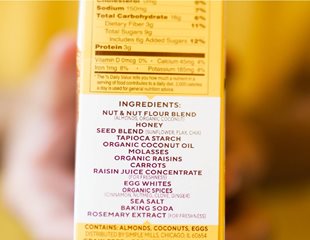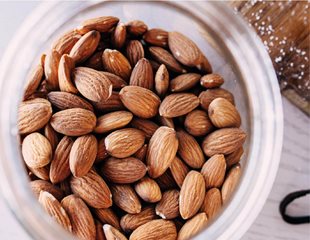When shopping the center aisles of the grocery store, you may encounter an array of foods that contain an overwhelming amount of information on their labels. Avoid shopping woes with these eight tips from Registered Dietician, Olivia Wagner (MS, RDN, LDN) for deciphering ingredient labels so you can shop for your favorite foods with confidence and ease.
#1 Avoid Chemical Preservatives
When reading food labels, avoid chemical preservatives like BHTA/BTA, calcium propionate, carcinogens, nitrates and sulfites, which have been linked to adverse side effects. Instead, choose foods with natural preservatives like essential oils, lemon juice and Vitamin E. These food products may have a shorter shelf life, but they have a lower health risk.
#2 Check Out the Ingredient Panel Before the Nutrition Facts
Before you read the nutrition information, check out the list of ingredients. Look for ingredients that are on “PAR,” which means ingredients should be Pronounceable, Appropriate for the food product and Recognizable as a whole food ingredient. By using the PAR method, you should be able to identify any added artificial chemicals, flavors or sugars.

#3 Choose Foods with More Grams of Protein than Sugar per Serving
Fat, fiber and protein can help support satiety and help keep blood sugar levels stable. When grocery shopping for foods like yogurt, be on the lookout for options that contain more protein than sugar. For example, look for plain whole milk Greek yogurt instead of commercially flavored yogurt, which can be laden with sugar and can contain very little protein. Try and keep the ratio of protein to sugar in balance and look for added fiber from whole food sources like fruit, nuts and seeds.
#4 Look for Less than 7g of Sugar per Serving
In packaged food products, look for foods with less than 7 grams of sugar per serving. If a food contains added sugar, select sources of sugar that come from whole foods like coconut, dates, dried fruit, honey or maple syrup, as these options contain more nutrients compared to refined sweeteners like cane sugar, corn syrup, fructose, maltodextrin and sucrose. When selecting foods, it’s always best to look for foods that contain the least amount of sugar even if they are from natural sources.
#5 Opt for Foods with Whole Food-Derived Colorings
Some food products may be brightly colored with vibrant shades of the rainbow. Select foods that contain whole food-derived coloring options like beet extract, spirulina and turmeric and avoid artificial colors like Blue 1, Red 40, Yellow 5 and Yellow 6. Chemically produced food dyes have been linked to a number of unwanted symptoms, so always choose whole-food derived coloring options whenever possible.
Tip: Looking to give your favorite frostings a natural hue? Check out this guide to making your own naturally dyed frosting at home.
#6 Prioritize Real Nutrients Over Fortified Ingredients
Just because a food product contains added minerals and vitamins doesn’t mean it carries more nutritional benefits. Many experts argue the human body does not absorb added nutrients in the same way as nutrients that are naturally occuring in whole food sources. Instead, boost your intake of minerals and vitamins by eating a variety of whole-food sources that are naturally nutritious or by medically guided supplementation from a primary care physician or a registered dietician.
.jpeg.aspx?width=310&height=240)
#7 Remember “Natural Flavors” Aren’t Always Natural
Foods that contain “natural flavors” doesn't mean these flavors come from natural sources. Natural flavors are typically derived from a chemical found in a natural source like fruits or vegetables. This chemical is then processed and combined with as many as 100 other ingredients. These flavor mixtures typically contain preservatives and solvents that can account for as much as 80-90% of the natural flavor volume. Avoid foods that contain natural flavors and instead aim for food products that are flavored with whole ingredients like alliums, citrus zest, herbs and spices. Some good options include basil, cinnamon, cumin, garlic, lemon zest, lime zest, onion, orange zest, oregano, paprika, rosemary and scallions.
#8 Select Foods with Nutrient-Dense Fats
When selecting food products, look for foods that contain nutrient-dense fats. Some high quality options include avocado, cacao butter, coconut, olives, nuts and seeds. Aim for high-quality plant-based oil products like avocado oil, cold-pressed nut and seed oils, organic sunflower oil, raw olive oil and unrefined coconut oil. The nutrient-dense fats food in these foods will keep you satiated so you feel fuller for longer. Avoid hydrogenated or partially hydrogenated oils, anything with the word “trans” in front of it, as these types of oils are not ideal for optimal health.

Reading ingredient labels doesn't have to be tedious or time consuming. Simply follow these eight tips the next time you are grocery shopping and fill your grocery cart with the best food products as possible.
Tag us @SimpleMills and show us your clean ingredient grocery haul.